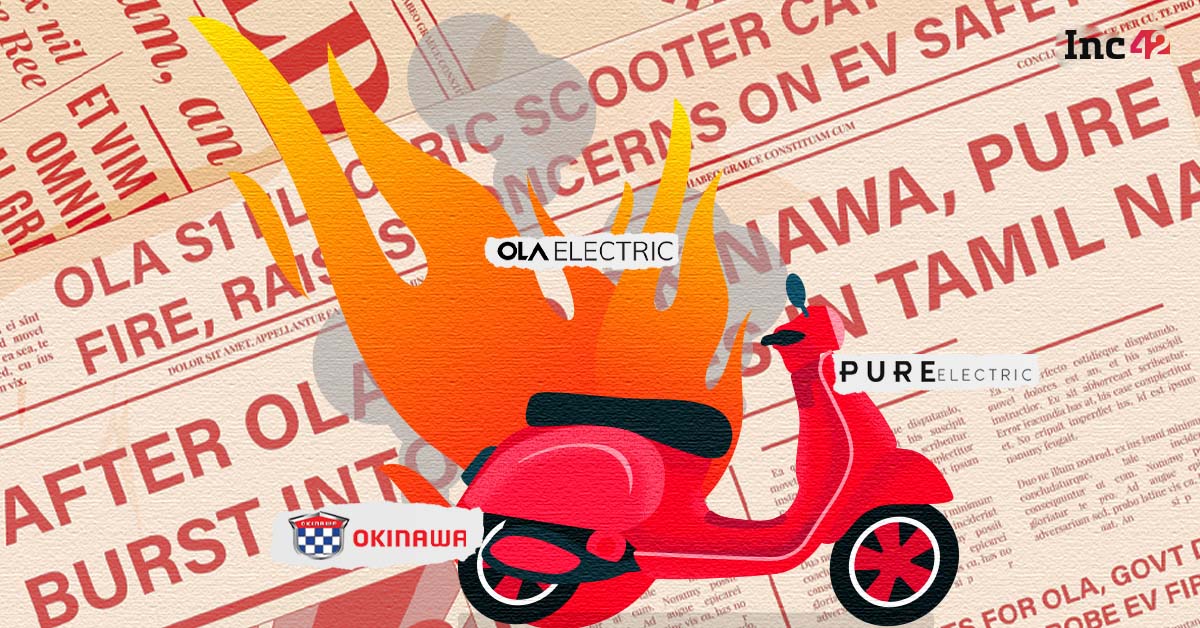After the hype around electric scooters and EV launches by the likes of Ola, Bounce, Simple, PureEV among other players, the Indian EV two-wheeler market is going through a rough patch. EV and electric scooter makers are caught in a bind now as a series of fire accidents in different parts of India involving reputed brands have resulted in a reality check.
Two lives were lost in Vellore in Tamil Nadu as an Okinawa scooter caught fire. Another fire incident involving EV unicorn Ola Electric’s S1 Pro was reported from Pune and in Chennai, a PureEV scooter went up in flames. These mishaps all occurred one after another in the space of a week.
The unfortunate incidents have dampened the enthusiasm for EVs and electric scooters, especially after the Union Budget announcement to promote battery swapping.
The mishaps and the focus on the lack of safety of EVs could not have happened at a worse time as many startups in this space have been going full speed in manufacturing and sales.
Even as the fledgling industry is allaying the apprehensions of users through customer awareness programmes, some immediate directives are expected from the government to enhance the safety aspects of electric scooters.
While stakeholders are confident that the government would not respond to the situation in a knee-jerk fashion, they are almost sure that issues with batteries are the root cause of fires in electric vehicles. Low-quality batteries that are not adequately tested for real-world conditions and other cost-cutting measures have been blamed for these fires.
Such fires had been seen in the past too, but accidents are occurring at an alarming frequency and the worst is yet to come according to some startup founders in the EV space.
What Causes EVs To Catch Fire?
According to Sambit Chakraborty, part of the advisory board for Indigrid Technology, which assembles battery packs for electric two-wheelers and three-wheelers, the root cause may be the low-quality imports of EV batteries. Cheap batteries from China or other regions have very few safety features.
“It all starts actually at the cell level. Lithium-ion cells have something called impedance. Chinese batteries have impedance ranges between 20 and 40. This causes the cells to overheat and this is the issue out there,” he said.
Impedance testing is a non-intrusive way of preventing battery failure by identifying early signs of weakness or general deterioration. This is vital for the management of lithium-ion cells in EV batteries.
In most cases, fire prevention is built into the battery management system (BMS), which tracks the heat generated at cell level. When it detects that the cells are overheating, the BMS shuts down power and dissipates the heat.
But often, the testing of the BMS, the battery efficacy, the heat generation and the reaction of batteries to thermal changes is conducted in controlled environments, which do not match real-world settings, according to commercial electric two-wheeler manufacturer Dispatch founder Rajit Arya.
The BMS, the design and the battery have to undergo rigorous testing at varying temperatures — all have a cost attached to them, but some products cannot be released in the market without adequate testing. Cost is not the factor here, Arya told Inc42, but actually, the reason is that companies want to rush out their products because of the current hype among early adopters.
Many EV battery makers are just importing the cheap Chinese cells, packing them into a pack and selling to manufacturers, Chakraborty added. This contributes to lower production costs and on-road prices which is what is used as a way to market these EVs.
Akash Gupta, co-founder & CEO, Zypp Electric, which makes commercial EVs, said, “Packaging of the battery pack is vital. If the battery is not packed correctly or carelessly or with substandard materials, it will lead to a short circuit, as in any electronic appliance, leading to fire.”
He also highlighted the use of non-coolant materials. “Skipping the step of using the right materials for coolants such that temperature is optimised within the pack can lead to such incidents.”
Busbars used to connect low-voltage equipment in battery banks also act like a fuse, just in case the BMS fails to detect overheating. There’s an aluminium casing or shielding that is another preventive measure against the heat spilling to the exterior and causing fires, Chakraborty said. But high standard safety features are not mandated in India. According to one industry observer, the ones that are catching fire are the ones with plastic casing.
While the cells, the input materials for any lithium-ion pack are imported, mainly from China, but also from South Korea and other Southeast Asian countries, the BMS, the busbar, the shielding and other systems are largely designed and manufactured by startups that are finally selling these scooters. So much of the testing burden rests on these EV makers, which they have largely neglected, added Disptach’s Arya.
Did Ola, Okinawa And Others Ignore Safety Testing?
After the repeated incidents of fire breaking out, manufacturers are now facing the criticism that electric scooters were probably rushed to the market overlooking safety aspects.
Arya pointed to how Ather has gone about launching its products after years of testing. At Dispatch, the company has been testing its commercial EVs for at least a year and will continue doing so till it goes into production later this year.
But in contrast, Ola Electric was able to release a scooter and promote it and sell it in something like 12-15 months. While Arya did not comment about Ola, he mentioned that in testing, one cannot throw money and manpower and expect the same results as rigorous testing, then iteration and then further testing for a period of time because seasonal testing also has to be conducted.
“If you buy a Maruti Alto, you will get certain features. If you buy a Volvo you get certain other safety features. But there is no such differentiation at the battery level,” Indigrid’s Chakraborty pointed out.
In peak summers, parts of India can touch up to 50 degrees Celsius. But testing at major companies is often only conducted in labs and under ideal conditions. This needs to change and if we don’t change it now, the situation will get worse in peak summers, added EV battery solutions startup Log9’s founder Akshay Singhal.
Ominously, he added that we are in store for more such incidents given the lack of action over the ones that have occurred already.
Another prominent EV player told us on the condition of anonymity that for many other players it was a valuation game. “Getting vehicles on the road, increasing value, increasing touch points and all that. They did not care. So, when batteries were failing, they were just saying okay, replace the thing. They were ignoring it by and large. Now, they are being forced to take notice.”
Insurance Can Make A Difference
The EV vehicle space at present is not well insured. Of late, some insurers have come up with custom EV insurance packages. Insurance is a check-and-balance step because insurers will devise their own coverage policy for electric vehicles after taking into consideration the safety of batteries and other parts.
“Insurance is coming a bit late because there are already tens of thousands of vehicles out there on the road, of various models and configurations,” Chakraborty said.
But the silence of the EV makers impacted by these incidents is alarming. In any other industry, there would be calls for a mass recall of the products. Samsung had to recall all models of its Galaxy Note 7 smartphone in 2016 after it was found that a manufacturing defect in the batteries caused the phones to overheat and even catch fires. The Korean giant is estimated to have lost $17 Bn as a result of this recall.
“In the past, we have seen phones and laptops regulated in a similar manner. But in the case of EVs, not only are the manufacturers not saying anything, but even the government is silent. It’s disconcerting to note that sales of such EVs are continuing even today even after lives have been lost”, Log9’s Singhal told Inc42.
The speculation is rife that the central government will soon issue mandatory norms for the registration and sale of EV vehicles. This is likely to include fire department clearance and fire safety certificates besides the provision to clamp a fire extinguisher in electric vehicles. The industry wants the government to hear out subject experts before these regulations.
A safety standard like an ISI is considered for a cylinder or a helmet can be introduced, along with giving directives on materials and connectors that EV players can use to maintain safety standards. But primarily testing has to be improved.
According to founders like Singhal, one cannot just launch an EV just because they have money; manufacturers need to be responsible in testing and cannot rush out products. The last thing the budding EV industry wants is a reputation of being unsafe.
[With Inputs From Nikhil Subramaniam]



![Read more about the article [Funding alert] Qarmatek, Un1Feed, AppX, MyCaptain, EduFund, others raise early-stage rounds](https://blog.digitalsevaa.com/wp-content/uploads/2021/12/Image03w0-1640781482458-300x150.jpg)





